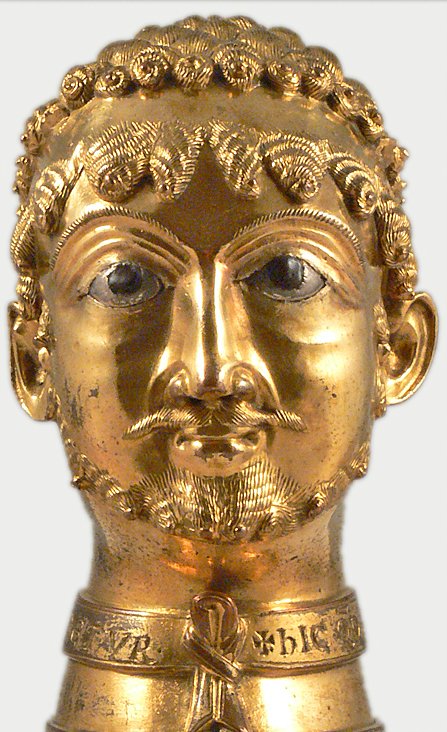Emperor Lothar III fought his way into Rome to be crowned #OTD, June 4, 1133 in the church of the Lateran by Pope Innocent II.
Nothing about this coronation was smooth. The city of Rome was split between two great aristocratic clans, the Frangipani and the Pierleoni. 🧵
Nothing about this coronation was smooth. The city of Rome was split between two great aristocratic clans, the Frangipani and the Pierleoni. 🧵

Each had put their candidate on the papal throne, the Frangipani Innocent II and the Pierleoni Anaclet II. Anaclet II held Rome and was allied with Roger II of Sicily, who he had made king. (2/ 

Innocent II had support in France, the empire, parts of Italy and more important than anything else of Bernhard of Clairvaux, the most eminent churchman in Europe. (3/ 

Rome was divided. The Pierleoni of Anaclet II held the bridge in Trastevere and the ancient Theatre of Marcellus in the Jewish quarter. The Frangipani main fortress was the Collosseum. (4/. 

Lothar had sided with innocent II which meant he had to take Rome from Anaclet II if he wanted to be crowned. He mustered an army that travelled with relative ease down to Rome. It was St. Bernhard who had made that possible by haranguing and harassing the major Italian cities.(5 

That meant it became an odd kind of imperial progress. No city was entered, no coronation to king of Italy in Monza or Pavia celebrated. The army sort of snuck down the road, saying please and thank you just trying to get to Rome in one piece. (6/
With the army still only about 2,000 men, the question arose what they were supposed to do when they get there. Sure they were the great German knights, but still no match for the mighty Sicilian Normans. (7/ 

And that is when they hit a patch of good fortune. King Roger of Sicily suddenly found himself having to fight off a major rebellion. Coincidence, maybe, or some well-placed bags of gold coins from the papal purse. To everyone’s surprise, the rebels were successful. (8/
They gave Roger a bloody nose and he had to shelter on the island of Sicily. No way that he could help Anaclet II now. (9/
Next piece of good news was that upon arrival in Rome the Frangipani allies opened the city gates. Anaclet retired to the right bank of the Tiber protected by the Castel Sant Angelo and the Theatre of Marcellus, whilst Innocent II and his Frangipani allies took the left bank. (10
With Anaclet II holding St. Peter, the coronation could only take place in the Basilica of the Lateran. There Lothar III and his wife Richeza were crowned emperor and empress on June 4th, 1133. (11/ 

Note the date. It is June and Malaria season is kicking off. Anaclet is still sitting pretty, and Roger II is gradually gaining ground in Southern Italy. (12/ 

Lothar thinks there is another opportunity to renegotiate the relationship between pope and empire. His offer: a revision of the Concordat of Worms plus the lands of Matilda for the continuation of the campaign. And again St. Bernard put a spanner in the works. (13/
No revision of the Concordat. And as for the lands of Matilda, well you can receive them as a papal vassal against a rent of 100 mark of silver annually, but it remains property of the pope and whoever is Margrave of Tuscany has to do military service for him. (14/
Lothar - as so many times before - prefers the sparrow in his hand to a dove on the roof and takes the offer. The position of Margrave of Tuscany and greatest of Italian lords is passed on to the imperial son-in-law, Henry the Proud, head of the house of Welf.(15/ 

But it was not enough to make him stay. The ink barely dry on the agreement, Lothar packed his bags and went home. If the pope offers no more than basic service, well, all he gets back in return is basic service. (16/
Lothar’s return was also the end of Innocent II’s stay in Rome. A few weeks later the Pierleoni had regained their positions on the left bank and Innocent had to leave by the same route as 3 years earlier. So, nothing had really changed. (17/
Innocent II will return to Rome, so will emperor Lothar III. The struggle between papacy and empire is by no means over. He will have a fresco painted to commemorate the coronation that will cause a rift between his successor and the mighty emperor Frederick Barbarossa. (18/ 

For more, check out episode 46 of the History of the Germans Podcast available on Apple podcasts, Spotify and all major platforms. this link takes you straight there: pod.fo/e/110a50
• • •
Missing some Tweet in this thread? You can try to
force a refresh

 Read on Twitter
Read on Twitter

















